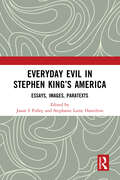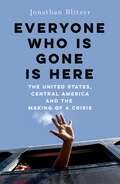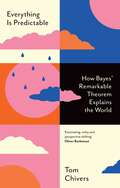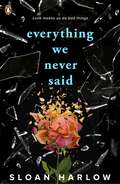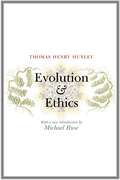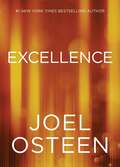- Table View
- List View
Every Body: Celebrate, respect and accept ALL bodies – especially your own
by Molly ForbesWe all have a body. They don't always function the same as other people's. And they certainly don't all look the same. But one thing is certain - every body deserves respect. This is an essential guide to embracing and respecting all bodies, for readers aged 9+.Sometimes social media can make us feel like we're not good enough if we don't have a 'perfect' body. But the truth is, everyone feels bad about their bodies sometimes – even celebrities with millions of followers.Author and campaigner Molly Forbes is here to show you that you - and ONLY you - get to decide how you feel about your body. And if we want to change the conversation around body image, we need to advocate for every single body - including those that look or function differently from our own.It's time to stop criticising the way we look, and celebrate all our glorious differences!
Everyday Eating: Food, Taste and Trends in Britain since the 1950s
by Alan WardeHow have eating habits changed in recent decades? What does it mean to eat well? This fascinating book examines continuity and change in food consumption and eating patterns since the 1950s. The culinary landscape of Britain is explored through discussion of commodification, globalisation and diversification enabling an understanding of both developing trends and enduring habits. The author’s research undertaken over 40 years offers fresh insights into such practices as everyday meals, shopping, cooking and dining out and how these are shaped by demographic, social and cultural processes. The book provides a comprehensive and engaging analysis of eating in Britain today and of the many controversies about how this has changed.
Everyday Eating: Food, Taste and Trends in Britain since the 1950s
by Alan WardeHow have eating habits changed in recent decades? What does it mean to eat well? This fascinating book examines continuity and change in food consumption and eating patterns since the 1950s. The culinary landscape of Britain is explored through discussion of commodification, globalisation and diversification enabling an understanding of both developing trends and enduring habits. The author’s research undertaken over 40 years offers fresh insights into such practices as everyday meals, shopping, cooking and dining out and how these are shaped by demographic, social and cultural processes. The book provides a comprehensive and engaging analysis of eating in Britain today and of the many controversies about how this has changed.
Everyday Evil in Stephen King's America: Essays, Images, Paratexts
This edited collection variously interrogates how everyday evil manifests in Stephen King’s now-familiar American imaginary; an imaginary that increases the representational limits of both anticipated and experienced realism. Divided into three parts: I. The Man, II. The Monster, and III. The Re-mediator, the book offers rigorous readings of evil, realism, and popular culture as represented in a range of texts (and paratexts) from the King canon. Rich with images, a photo-essay, and appendices collecting classical texts and cultural detritus germane to King, this book moves away from viewing King’s work primarily through the lens of the “American gothic” and toward the realism that the suspense novelist’s voice (fictional and non-) and influence (literary and popular) indelibly continue to amplify, all the while complicating the traditional divide between serious literature and popular fiction.Stephen King remains perpetually popular. And he is finally receiving the academic treatment he has craved since the early 1980s. Yet still unexamined in the King critical canon is the suspense novelist’s fascination with “everyday evil.” Beyond rigorous interrogations of King’s fictional depictions of “everyday evil” by an array of scholars of different ranks living around the world (Canada, Finland, Hong Kong, the UK), the book, replete with 20 images, considers how King widens the parameters of literary production and appreciation. An integral part of the Americana that King’s five-decades-in-the-making canon configures, of course, includes King himself. King has long made use of self-referentiality in his fiction and nonfiction. Some of his nonfiction, several of our essays reveal, recirculates in paratextual form as “Prefatory Remarks” to new novels or new editions of older ones. The paratexts considered here (both across the volume and in the appendices) offer alternate ways by which to appreciate King and his sphere of influence (literary and popular). Said appendices are a grouping of King's paratexts on his writing as Bachman, appearing here, for the first time, as a cohesive collection. King's influence took off in the 1970s, as is further explored in the book-enveloping three-part photo-essay “King’s America, America’s King: Stephen King & Popular Culture since the 1970s.” About the transformative quality of “everyday evil,” the photo-essay tracks the cultural impacts of King first as an emerging author, then a pop culture phenomenon, and, finally, as an established American literary voice.Everyday Evil in Stephen King's America is designed to appeal to teachers and students of American literature, to Stephen King enthusiasts, as well as to acolytes of Americana since the Vietnam War.
Everyday Evil in Stephen King's America: Essays, Images, Paratexts
by Jason S Polley Stephanie Laine HamiltonThis edited collection variously interrogates how everyday evil manifests in Stephen King’s now-familiar American imaginary; an imaginary that increases the representational limits of both anticipated and experienced realism. Divided into three parts: I. The Man, II. The Monster, and III. The Re-mediator, the book offers rigorous readings of evil, realism, and popular culture as represented in a range of texts (and paratexts) from the King canon. Rich with images, a photo-essay, and appendices collecting classical texts and cultural detritus germane to King, this book moves away from viewing King’s work primarily through the lens of the “American gothic” and toward the realism that the suspense novelist’s voice (fictional and non-) and influence (literary and popular) indelibly continue to amplify, all the while complicating the traditional divide between serious literature and popular fiction.Stephen King remains perpetually popular. And he is finally receiving the academic treatment he has craved since the early 1980s. Yet still unexamined in the King critical canon is the suspense novelist’s fascination with “everyday evil.” Beyond rigorous interrogations of King’s fictional depictions of “everyday evil” by an array of scholars of different ranks living around the world (Canada, Finland, Hong Kong, the UK), the book, replete with 20 images, considers how King widens the parameters of literary production and appreciation. An integral part of the Americana that King’s five-decades-in-the-making canon configures, of course, includes King himself. King has long made use of self-referentiality in his fiction and nonfiction. Some of his nonfiction, several of our essays reveal, recirculates in paratextual form as “Prefatory Remarks” to new novels or new editions of older ones. The paratexts considered here (both across the volume and in the appendices) offer alternate ways by which to appreciate King and his sphere of influence (literary and popular). Said appendices are a grouping of King's paratexts on his writing as Bachman, appearing here, for the first time, as a cohesive collection. King's influence took off in the 1970s, as is further explored in the book-enveloping three-part photo-essay “King’s America, America’s King: Stephen King & Popular Culture since the 1970s.” About the transformative quality of “everyday evil,” the photo-essay tracks the cultural impacts of King first as an emerging author, then a pop culture phenomenon, and, finally, as an established American literary voice.Everyday Evil in Stephen King's America is designed to appeal to teachers and students of American literature, to Stephen King enthusiasts, as well as to acolytes of Americana since the Vietnam War.
Everyday Ways to Connect with Your Adopted or Fostered Child: Over 200 Quick and Simple Ways to Build Relationships and Open Conversations
by Fiona BiggarThis indispensable guide has over 200 simple, easy to implement therapeutic parenting activities which you can easily build into everyday life. Starting with a simple explanation of therapeutic parenting and how to do it, it provides a host of strategies and activities to help tackle common challenges faced by families affected by trauma. This includes improving communication and relationships, lessening conflict, building confidence, creating structure and routine, and handling big emotions. The activities range from short daily check-ins to reinforce attachment through to creative therapeutic activities. The ideas in this book will help create an environment of acceptance, safety, and respect, and enable you and your child to build a stronger, more connected relationship.
Everyone Who Is Gone Is Here: The United States, Central America, and the Making of a Crisis
by Jonathan Blitzer'Urgent, extraordinary . . . a tribute to the astonishing indomitability of the human spirit.' - Patrick Radden Keefe, bestselling author Empire of Pain'Moving, sweeping, and masterful' - Sally Hayden, author of My Fourth Time, We DrownedNew Yorker journalist Jonathan Blitzer has been covering the immigration crisis at America’s southern border for nearly a decade, but the current emergency is the end of a much larger story. In this, his first book, Blitzer goes back to the beginning: to the shadowy civil wars in El Salvador and Guatemala in the 1980s; to the American prison system in the 1990s and the policies of mass deportation that transformed local street criminals into international crime syndicates; to Honduras’s brutal crackdown on crime in the 2000s and the emergence of gangs across Central America and the United States. And then the Trump era, in which immigration became a vector of resurgent populism, with mass internments the order of the day.Everyone Who Is Gone Is Here is a fresh and full account of America’s immigration problems, but it is much more than that. It is an odyssey of struggle and resilience, telling the epic story of people whose lives ebb and flow across the border and those who help and hinder them. It is a gripping and persuasive attempt to answer not only the question of how America got there, but the vital question of who we are and who we want to be in our liberal Western democracies, whether we are incarcerating children on our southern borders or watching them drown on the shores of the Mediterranean.'What an incredibly thorough documentation of the causes of the immigration crisis, the discussions that have been going on through multiple administrations.' - Jon Stewart, The Daily Show
Everything Is Predictable: How Bayes' Remarkable Theorem Explains the World
by Tom ChiversThomas Bayes was an eighteenth-century Presbyterian minister and amateur mathematician whose obscure life belied the profound impact of his work. Like most research into probability at the time, his theorem was mainly seen as relevant to games of chance, like dice and cards. But its implications soon became clear. Bayes' theorem helps explain why highly accurate screening tests can lead to false positives, causing unnecessary anxiety for patients. A failure to account for it in court has put innocent people in jail. But its influence goes far beyond practical applications. A cornerstone of rational thought, Bayesian principles are used in modelling and forecasting. 'Superforecasters', a group of expert predictors who outperform CIA analysts, use a Bayesian approach. And many argue that Bayes' theorem is not just a useful tool, but a description of almost everything - that it is the underlying architecture of rationality, and of the human brain. Fusing biography, razor-sharp science communication and intellectual history, Everything Is Predictable is a captivating tour of Bayes' theorem and its impact on modern life. From medical testing to artificial intelligence, Tom Chivers shows how a single compelling idea can have far-reaching consequences.
Everything We Never Said
by Sloan HarlowDark romance, high stakes and plot twists abound in Sloan Harlow’s debut YA thriller, perfect for fans of Colleen Hoover.The dead keep the best secrets . . .It’s been months since Ella’s best-friend, Hayley, died and everywhere she looks she sees reminders of her – including Sawyer, Hayley’s boyfriend. Soon, the two grow closer, finding comfort in each other.Racked with guilt, Ella turns to Hayley’s journal, but what she finds leaves her terrified. The Sawyer in these pages is nothing like the kind and thoughtful boy she knows. Torn, Ella finds herself having to make a choice. Yet making the wrong one could have fatal consequences . . .
Evidence‐Based Neurological Disorders: Symptoms, Causes, and Therapy
by Sushil Kumar Upadhyay Siddhartha Dan Sheikh Abid AliNeurology is one of the most fascinating areas of medical science and general biology but it has traditionally been limited to some dedicated aspects only. However, modern neuroscience has embarked on exciting and diverse frontiers related to the causes, diagnosis, and treatment of neurological disease and nowadays, neurology has become multidisciplinary. There are many books available that deal with only one key concept of neurology but a book with a multidisciplinary approach is lacking so far.This book emphasizes all the conventional and applied divisions associated with neurology in reference to medical physiology and general biology and covers all aspects to integrate the topics of inter-related approaches. It provides complete information on each aspect of neurodegenerative disorders and brain injury, including autonomic nervous system, neuro-oncology, cerebellar ataxias, spinal cord disorders, neuro-ophthalmic disorders, and neuro-otological disorders such as dizziness, vertigo, imbalance, and hearing impairments, in a concise and informative way. It highlights the challenges related to neurological disorders along with their ongoing molecular mechanisms and treatments. The book provides simple and reader-friendly representations and artwork that will help in understanding the concepts.
Evidence‐Based Neurological Disorders: Symptoms, Causes, and Therapy
by Sushil Kumar Upadhyay Siddhartha Dan Sheikh Abid AliNeurology is one of the most fascinating areas of medical science and general biology but it has traditionally been limited to some dedicated aspects only. However, modern neuroscience has embarked on exciting and diverse frontiers related to the causes, diagnosis, and treatment of neurological disease and nowadays, neurology has become multidisciplinary. There are many books available that deal with only one key concept of neurology but a book with a multidisciplinary approach is lacking so far.This book emphasizes all the conventional and applied divisions associated with neurology in reference to medical physiology and general biology and covers all aspects to integrate the topics of inter-related approaches. It provides complete information on each aspect of neurodegenerative disorders and brain injury, including autonomic nervous system, neuro-oncology, cerebellar ataxias, spinal cord disorders, neuro-ophthalmic disorders, and neuro-otological disorders such as dizziness, vertigo, imbalance, and hearing impairments, in a concise and informative way. It highlights the challenges related to neurological disorders along with their ongoing molecular mechanisms and treatments. The book provides simple and reader-friendly representations and artwork that will help in understanding the concepts.
Evolution and Ethics: And Other Essays
by Thomas Henry HuxleyHuxley's classic lecture on evolution, human nature, and the way to true happinessThomas Henry Huxley (1825–1895) was one of the most prominent evolutionists of the late nineteenth century. A close companion of Charles Darwin, Huxley developed a reputation as "Darwin's Bulldog" for his relentless defense of evolutionary theory. Huxley was also an ardent supporter of social reform, particularly in his call for quality education at all levels. Evolution and Ethics, widely considered to be his greatest lecture, distilled a lifetime's wisdom and sensitive understanding of the nature and needs of humankind. Arguing that the human psyche is at war with itself, that humans are alienated in the cosmos, and that moral societies are necessarily in conflict with the natural conditions of their existence, Huxley nevertheless saw moral dictates as the key to future human happiness and success. This beautiful edition features an introduction by renowned historian and philosopher of biology Michael Ruse, placing Huxley's lecture in its original context while showing its even deeper relevance for our own time.
The Evolution of Authoritarianism and Contentious Action in Russia (Elements in Contentious Politics)
by null Bogdan MamaevThis Element examines the evolution of authoritarianism in Russia from 2011 to 2023, focusing on its impact on contentious action. It argues that the primary determinant of contention, at both federal and regional levels, is authoritarian innovation characterized by reactive and proactive repression. Drawing on Russian legislation, reports from human rights organizations, media coverage, and a novel dataset of contentious events created from user-generated reports on Twitter using computational techniques, this Element contributes to the understanding of contentious politics in authoritarian regimes, underscoring the role of authoritarianism and its innovative responses in shaping contentious action.
The Evolution of Gerald Durrell: Biography of an Author and Wildlife Conservationist
by Professor Mary Sanders PollockIn The Evolution of Gerald Durrell: A Naturalist's Critical Biography, Mary Sanders Pollock revisits the life and work of Gerald Durrell, one of the most significant environmentalist figures of the 20th century. This new biography tracks Durrell's evolution from a free-range childhood on Corfu through his time in Africa, South America, and the islands of the Pacific and Indian Oceans. Durrell's early work is described in his numerous travel narratives, but his conservation activities culminated in “the stationary ark,” a conservation zoo on the Isle of Jersey which still plays an important role in global wildlife conservation efforts. This biography situates Durrell's writing, collecting, and conservation practices within the frameworks of animal studies, conservation biology, and postcolonial history. Familiarizing readers with the broad range of his cultural impact, from The Corfu Trilogy to his BBC television specials, Pollock shows how Durrell's approach offers models for how life on earth is to thrive and survive: scientists must make greater efforts to touch hearts and minds, and cultural workers must communicate more about science and the perilous existence of other species.
The Evolution of Life: Teaching, Learning and Training - New Approaches on Current Research in the Didactics of Evolution
by Corinne Fortin Julie GobertThe aim of this collective work is to give an account of the topicality and dynamics of new research in the didactics of evolution, by articulating francophone and international work. The various contributions pursue a reflection on the challenges of teaching and learning about evolution, based on historical, epistemological and societal approaches. The themes addressed illustrate the vitality and diversity of research issues in educational sciences, from primary school to university. Structured around different theoretical fields (problematization, didactics of the curriculum, nature of science, etc.), this book explores the content, teaching and learning processes and approaches, teaching practices, as well as pre-service and in-service teacher training, with a view to both intelligibility and feasibility.
The Evolution of Life: Teaching, Learning and Training - New Approaches on Current Research in the Didactics of Evolution
by Corinne Fortin Julie GobertThe aim of this collective work is to give an account of the topicality and dynamics of new research in the didactics of evolution, by articulating francophone and international work. The various contributions pursue a reflection on the challenges of teaching and learning about evolution, based on historical, epistemological and societal approaches. The themes addressed illustrate the vitality and diversity of research issues in educational sciences, from primary school to university. Structured around different theoretical fields (problematization, didactics of the curriculum, nature of science, etc.), this book explores the content, teaching and learning processes and approaches, teaching practices, as well as pre-service and in-service teacher training, with a view to both intelligibility and feasibility.
Evolution Seen from the Phase Diagram of Life (Evolutionary Studies)
by Shigeki Mitaku Ryusuke SawadaThis book aims to understand biological evolution through a physical approach, focusing on the macroscopic aspects of the biological genome. Readers will discover the connection between genomic information and the harmony of biological systems, a relationship that remains elusive to many researchers in biological sciences.The most common approach to understanding living organisms with physics is to begin with a single molecule of an organism. In contrast to this bottom-up approach, building from each molecule to the whole, this book takes a coarse-grained approach at the amino acid level to physically understand the macroscopic aspects of the organism. The book presents a system developed by the authors to predict membrane proteins with high accuracy using only physical parameters. Another distinctive perspective of this book is that it proposes the idea of a physical mechanism, other than natural selection, that orchestrates the emergence of order from random processes.The study of macroscopic aspects of living organisms based on this concept has parallels with thermostatistical mechanics for states of matter. Just as random processes create order in matter, there are physical random processes that form order in living organisms. This analogy is the central theme of the book.Using terms and analogies familiar to physicists, the book bridges the gap between biological and physical sciences. The book focuses on simple principles and is aimed primarily at researchers. While the content of this book is at the boundary area of biophysics, soft matter physics and bioinformatics, it will also be of interest to researchers and graduate students working on any biological topics.
Evolutionäre Verhaltensökologie und Psychopathie
by Janko MeđedovićDieses Buch beleuchtet das Forschungsgebiet der Psychopathie anhand eines verhaltensökologischen Rahmens. Es besteht aus zwei Teilen. Der erste Teil vermittelt wissenschaftliche Erkenntnisse der menschlichen Verhaltensökologie, einschließlich:Grundlegende Konzepte der EvolutionsbiologieEvolutionäre VerhaltenswissenschaftenEvolutionsökologie der FamilieEvolutionäre KompromisseTheorie der LebensgeschichteVerhaltensökologie der PersönlichkeitPsychopathie und ihre aktuelle Entwicklung.Der zweite Teil des Buches beschreibt die empirische Forschung zur Psychopathie in einem evolutionsökologischen Kontext, der darauf abzielt, Kompromisse zwischen Fruchtbarkeit und Lebenserwartung bei Psychopathie, interagierende Phänotypen bei Psychopathie und elterliche Effekte im Zusammenhang mit Psychopathie zu untersuchen. Dieser Teil enthält die Diskussion der Ergebnisse der Studie, die auf mehreren theoretischen Konzepten basiert, die im ersten Teil beschrieben wurden.Dieser Band ist ideal für alle Wissenschaftler, die sich mit dem Thema Psychopathie beschäftigen und eine neue und zukunftsorientierte Brücke zwischen den Natur- und Sozialwissenschaften bauen wollen.Die Übersetzung wurde mit Hilfe von künstlicher Intelligenz durchgeführt. Eine anschließende menschliche Überarbeitung erfolgte vor allem in Bezug auf den Inhalt.
Evolutionary Economics (Springer Texts in Business and Economics)
by Yuji ArukaThis textbook presents a new way to visualize or imagine the evolutionary architecture of economics, to judge both its practical outcomes and its ultimate value. Evolutionary economics employs an Aristotelian architecture. The cognitive value of this imagination[H1] must be directly relevant to the evolutionary theory and practice of designing the architecture of the economic system. Mainstream economics completely ignores design value in order to concentrate on the ideal, Platonic vision of the economy. The current system is no longer one that converges on a constant entity, because the system is constantly evolving. The advent of the digital economy is an indispensable next step, and computational power and algorithmic rationality are increasingly dominating the economic system—and complicating it. In today’s society, neither fault nor malice matters in the algorithmic or human system. There is little room left for the effective working of human reason. Correspondingly, the meanings of money, exchange, the market system, auctions, production, consumption, and the currency transaction system are poised to change. In most cases, there will be digital counterparts. A smart contract tied together with DLT, for example, makes it possible to design an economically well-behaved peer-to-peer (P2P) system, which ranges from the micromarket to the international currency transaction system. The introduction of this technology and its architectural design may suggest what a truly decentralized future entails. This change may also bring about a new understanding of existing social consensus and practice. Thus, the implementation of these considerations naturally leads to a new style of chapter structuring in this book, from the classical analytical approach to exploring computational methods and digital tools: in many cases, the problems presented in each chapter are combined with discussions of a respective computational method and its practical value.
Evolutionary Games and the Replicator Dynamics (Elements in Evolutionary Economics)
by null Saul Mendoza-Palacios null Onésimo Hernández-LermaThis Element introduces the replicator dynamics for symmetric and asymmetric games where the strategy sets are metric spaces. Under this hypothesis the replicator dynamics evolves in a Banach space of finite signed measures. The authors provide a general framework to study the stability of the replicator dynamics for evolutionary games in this Banach space. This allows them to establish a relation between Nash equilibria and the stability of the replicator for normal a form games applicable to oligopoly models, theory of international trade, public good models, the tragedy of commons, and War of attrition game among others. They also provide conditions to approximate the replicator dynamics on a space of measures by means of a finite-dimensional dynamical system and a sequence of measure-valued Markov processes.
Evolving European Perceptions Amidst Asian Neighbours: New Zealand's Merging with the Orient (Palgrave Series in Asia and Pacific Studies)
by David HallThis book identifies the formation, development and changes in New Zealand perceptions of its Asian neighbours, the work of which is based mainly on New Zealand sources—newspaper reports, Government and Parliamentary papers and documents from New Zealand individuals and organisations. The target audience is those with interest in how European perceptions of Asia were formed in the 19th century and Asia's response to those perceptions and how a country with a strong European culture copes with the need to better integrate with Asian neighbours.
Ex-Combatants and International Statebuilding: Veterans as Peace Brokers in Kosovo (Routledge Studies in Intervention and Statebuilding)
by Nathalie DuclosThis book examines the international efforts to regulate violence in Kosovo since 1999 through the United Nations Mission in Kosovo (UNMIK) and covers 15 years of international presence.The book analyses the process of implementing international policies from a sociological perspective, and looks at the adaptations and arrangements of public policies achieved through the transactions of international actors with local actors, who are at the heart of policy implementation. In particular, it analyses the disarmament, demobilisation, and reintegration of combatants (DDR) programme and shows the extent to which it was co-produced with Kosovo Liberation Army (KLA) leaders co-opted by international administrators. These analyses take the opposite view to the work that considers ex-combatants as spoilers. In Kosovo, the combatant leaders acted as peace brokers, facilitating demobilisation and exercising disciplinary control over rank-and-file combatants. Their position as brokers helped them to take control of the new state being built under international administration. This book shows the importance of the relationship between ex-combatants and the state and illustrates the multiplicity of their possible trajectories, including political ones. To elucidate the dynamics of co-production in shaping DDR policies and hybridising international policies as well as in state formation, the book relies on around a hundred interviews with ex-combatants of the KLA and with international personnel, as well as on the archives of international organisations and observations in the field.This book will be of much interest to students of international statebuilding, peace and conflict studies, Balkan politics and international relations.
Ex-Combatants and International Statebuilding: Veterans as Peace Brokers in Kosovo (Routledge Studies in Intervention and Statebuilding)
by Nathalie DuclosThis book examines the international efforts to regulate violence in Kosovo since 1999 through the United Nations Mission in Kosovo (UNMIK) and covers 15 years of international presence.The book analyses the process of implementing international policies from a sociological perspective, and looks at the adaptations and arrangements of public policies achieved through the transactions of international actors with local actors, who are at the heart of policy implementation. In particular, it analyses the disarmament, demobilisation, and reintegration of combatants (DDR) programme and shows the extent to which it was co-produced with Kosovo Liberation Army (KLA) leaders co-opted by international administrators. These analyses take the opposite view to the work that considers ex-combatants as spoilers. In Kosovo, the combatant leaders acted as peace brokers, facilitating demobilisation and exercising disciplinary control over rank-and-file combatants. Their position as brokers helped them to take control of the new state being built under international administration. This book shows the importance of the relationship between ex-combatants and the state and illustrates the multiplicity of their possible trajectories, including political ones. To elucidate the dynamics of co-production in shaping DDR policies and hybridising international policies as well as in state formation, the book relies on around a hundred interviews with ex-combatants of the KLA and with international personnel, as well as on the archives of international organisations and observations in the field.This book will be of much interest to students of international statebuilding, peace and conflict studies, Balkan politics and international relations.
Excellence
by Joel Osteen#1 New York Times bestselling author Joel Osteen helps readers achieve new levels of success and hope in their lives, no matter their current circumstances. You were created to be a cut above, to stand out in a crowd, and rise above average to exceptional. Indeed, the only way to be truly happy and successful is to live with a commitment to excellence and integrity in all you do. Favor, increase, promotion, and reaching your highest potential are all tied to a spirit of excellence. When you strive to be excellent, you&’re always taking steps to grow, to make the most of every opportunity, to go the extra mile. You do your best and do what&’s right whether anyone is watching or not. When you live a life of excellence, you will outperform, outclass, and outshine, and God will promote you and set you in a place of honor. This compact digest by #1 New York Times bestselling author JOEL OSTEEN helps you to keep improving, to stay focused, to stay passionate, and to make a habit of excellence. He encourages readers to get out of their comfort zones and make the rest of their life the best of their life. Joel can be heard 24/7 on SiriusXM 128—Joel Osteen Radio. Connect with Joel on Facebook, Twitter, and Instagram or visit his website at joelosteen.com. Derived from material previously published in You Can, You Will, The Power of I Am, and Break Out!
Exercise Well With Autoimmunity
by Zoe MckenzieWe're told that we need to exercise to stay healthy, but we're not told HOW to exercise. We're certainly not told how to exercise with an autoimmune condition. This is the definitive book you need to help you understand and support your body when exercising with an autoimmune condition.Here, Zoe tells us of her own health journey, whilst exploring the benefits of exercise for someone with an autoimmune condition and how you can get onto a plan that suits your needs. She uses case studies, experts and her own research to explore:- the benefits of exercising with a chronic condition- the barriers to exercising with a chronic condition and how to overcome them- how to keep motivation high when exhausted - which exercises you should do (complete with illustrations)- how to adapt your exercises depending on your condition- how to get into the right mindset with exerciseZoe teaches with compassion and understanding that is unique in this field and brings to market a guide that covers all aspects of exercising with chronic conditions, including simple, clear practices that you can put into action and meld into part of your balanced lifestyle programme.



